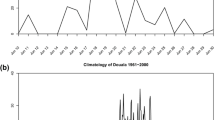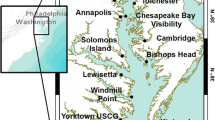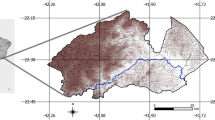Abstract
The capability of numerical models in simulating severe weather is related to the setting up of the parameters in the model, and the dynamical and physical schemes implemented in the model. Every model is not able to make accurate predictions in different time and locations. The Advanced Regional Prediction System (ARPS) was used with three different horizontal resolutions (30, 10, and 4 km) to simulate a severe snow storm in the south of the Caspian Sea, focusing primarily on the Tehran metropolitan area. This extratropical cyclone is selected due to its heavy precipitation (up to 3 m of snow in some regions) and a significant damage in terms of human and financial losses, as well as the variety forms of precipitation during its activity, including snow, rain, and hail. The ARPS model is used because the current operational numerical model, the Weather Research and Forecasting (WRF), at the national forecasting center of Iran does not predict well such an extreme event, particularly on the east coast of the Caspian Sea. Quantitatively speaking, our large-scale analyses show that there is a low bias in the simulated surface pressure, although the pressure patterns have generally admissible similarity with the observations. Geopotential height at 500 hPa is in reasonable agreement with the GFS reanalysis (here after observations). In terms of precipitation, the maximum values are simulated to be on the coasts of the Caspian Sea. In the innermost domain with 4-km horizontal resolution, precipitation values have been compared against the observations. The accumulative precipitation values in most of the weather stations are more than the actual values. Simulation results also indicate that in Mehrabad airport (center of Tehran) the model has successfully predicted vertical profiles of the considered variables.










Similar content being viewed by others
References
Chen C (1991) A nested grid, nonhydrostatic, elastic model using a terrain-following coordinate transformation: the radiative-nesting boundary condition. Mon Weather Rev 119:2852–2869
Dawod GM, Mirza MN, Al-Ghamdi KA (2013) Assessment of several flood estimation methodologies in Makkah metropolitan area, Saudi Arabia. Arab J Geosci 6:985–993
Evans JP, Smith RB, Oglesby RJ (2004) Middle East climate simulation and dominant precipitation processes. Int J Climatol 24:1671–1694
Ghoneim E, Foody GM (2013) Assessing flash flood hazard in an arid mountainous region. Arab J Geosci 6:1191–1202
Gilmore MS, Straka JM, Rasmussen EN (2004) Precipitation and evolution sensitivity in simulated deep convective storms: comparisons between liquid-only and simple ice and liquid phase microphysics. Mon Weather Rev 132:1897–1916
Iqbal MJ, Ali M (2012) A probabilistic approach for estimating return period of extreme annual rainfall in different cities of Punjab. Arab J Geosci 6:2599–2606
Kain JS (1993) Convective parameterization for mesoscale models: the Kain-Fritsch scheme. The representation of cumulus convection in numerical models. Meteor Monogr 46:165–170
Kousari MR, Zarch MAA (2011) Minimum, maximum, and mean annual temperatures, relative humidity, and precipitation trends in arid and semi-arid regions of Iran. Arab J Geosci 4:907–914
Krichak SO, Tsidulko M, Alpert P (2000) November 2, 1994 severe storms in the southeastern Mediterranean. Atmos Res 53:45–62
Lorenz EN (1969) The predictability of a flow which possesses many scales of motion. Tellus 21:289–307
Ming Liu D, Westphal L, Holt TR, Qin X (2000) Numerical simulation of a low-level jet over complex terrain in southern Iran. J Appl Meteorol 40:1095–1104
Rauber RM, Olthoff LS, Ramamurthy MK, Miller D, Kunkel KE (2001) A synoptic weather pattern and sounding-based climatology of freezing precipitation in the United States east of the Rocky Mountains. J Appl Meteorol 40:1724–1747
Şen Z, Al AlSheikh A, Al-Turbak AS, Al-Bassam AM, Al-Dakheel AM (2013) Climate change impact and runoff harvesting in arid regions. Arab J Geosci 6:287–295
Sun W-Y, Chang C-Z (1986) Diffusion model for a convective layer. Part I: numerical simulation of convective boundary layer. J Clim Appl Meteorol 25:1445–1453
Ulbrich U, Fink AH, Klawa M, Pinto JG (2001) Three extreme storms over Europe in December 1999. Weather 56:70–80
Westphal DL, Holt TR, Chang SW, Baker NL, Hogan TF, Brody LR, Godfrey RA, Goerss JS, Cummings JA, Laws DJ, Hines CW (1999) Meteorological reanalysis for the study of Gulf War illnesses: Khamisiyah case study. Weather Forecast 14:215–241
Xue M, Droegemeier KK, Wong V (2000) The Advanced Regional Prediction System (ARPS)—a multiscale nonhydrostatic atmospheric simulation and prediction tool. Part I: model dynamics and verification. Meteorol Atmos Phys 75:161–193
Xue M, Droegemeier KK, Wong V Shapiro A, Brewster K, Carr F, Weber D, Liu Y, Wang DH (2001) The Advanced Regional Prediction System (ARPS)—a multiscale nonhydrostatic atmospheric simulation and prediction tool. Part II: model physics and applications
Yau MK, Liu Y, Zhang DL, Chen Y (2004) A multiscale numerical study of hurricane Andrew (1992). Part VI: small-scale inner-core structures and wind streaks. Mon Weather Rev 132:1410–1433
Author information
Authors and Affiliations
Corresponding author
Rights and permissions
About this article
Cite this article
Farahani, M.M., Alizadeh, O., Khansalari, S. et al. Assessment of numerical model predictions of a severe weather in northern Iran: a case study. Arab J Geosci 8, 2899–2909 (2015). https://doi.org/10.1007/s12517-014-1312-3
Received:
Accepted:
Published:
Issue Date:
DOI: https://doi.org/10.1007/s12517-014-1312-3




